Caracal
| Caracal | |
|---|---|

| |
| Scientific classification | |
| Domain: | Eukaryota |
| Kingdom: | Animalia |
| Phylum: | Chordata |
| Class: | Mammalia |
| Order: | Carnivora |
| Suborder: | Feliformia |
| Family: | Felidae |
| Subfamily: | Felinae |
| Genus: | Caracal |
| Species: | C. caracal
|
| Binomial name | |
| Caracal caracal (Schreber, 1776)
| |
| Subspecies | |
|
See text | |
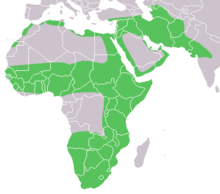
| |
| Caracal distribution | |
| Synonyms[2] | |
|
List
| |
The caracal (Caracal caracal) is a medium-sized wild cat native to Africa, the Middle East, Central Asia, and India. It is characterised by a robust build, long legs, a short face, long tufted ears, and long canine teeth. Its coat is uniformly reddish tan or sandy, while the ventral parts are lighter with small reddish markings. It reaches 40–50 cm (16–20 in) at the shoulder and weighs 8–18 kg (18–40 lb). It was first scientifically described by German naturalist Johann Christian Daniel von Schreber in 1776. Three subspecies are recognised since 2017.
Typically nocturnal, the caracal is highly secretive and difficult to observe. It is territorial, and lives mainly alone or in pairs. The caracal is a carnivore that typically preys upon small mammals, birds, and rodents. It can leap higher than 3 m (9.8 ft) and catch birds in midair. It stalks its prey until it is within 5 m (16 ft) of it, after which it runs it down, the prey being killed by a bite to the throat or to the back of the neck. Breeding takes place throughout the year, with both sexes becoming sexually mature by the time they are a year old. Gestation lasts between two and three months, resulting in a litter of one to six kittens. Juveniles leave their mothers at nine to ten months, though a few females stay back with their mothers. The average lifespan of the caracal in captivity is nearly 16 years.
Caracals have been tamed and used for hunting since the time of ancient Egypt.[3][4]
Taxonomy and evolution
The caracal was first described by German naturalist Johann Christian Daniel von Schreber as Felis caracal in 1776.[5] In 1843, British zoologist John Edward Gray placed it in the genus Caracal. It is placed in the family Felidae and subfamily Felinae.[2]
In the 19th and 20th centuries, several caracal specimens were described and proposed as subspecies. Since 2017, three subspecies are recognised as valid:[6]
- Southern caracal (C. c. caracal) (Schreber, 1776) – occurs in Southern and East Africa
- Northern caracal (C. c. nubicus) (Fischer, 1829) – occurs in North and West Africa
- Asiatic caracal (C. c. schmitzi) (Matschie, 1912) – occurs in Asia
Results of phylogenetic studies indicated that the caracal evolved nearly a million years before the lynx.[7] It is most closely related to the African golden cat (Caracal aurata). These two species together with the serval (Leptailurus serval) form the Caracal lineage, which evolved 8.5 million years ago (Mya). The ancestor of this lineage arrived in Africa 8.5–5.6 Mya.[8][9] It diverged from the serval probably within the last five million years, between the Pliocene and the Pleistocene.[10]
Since 2006, the phylogenetic relationships of the caracal is indicated as follows:[7][9]
| |||||||||||||||||||||||||||||||||||||||||||
Etymology
The name "caracal" is composed of two Turkic words: kara, meaning black, and kulak, meaning ear. The first recorded use of this name dates back to 1760.[11] Alternative names for the caracal include gazelle cat, red cat, rooikat, and red[citation needed] or Persian lynx.[12] The "lynx" of the Greeks and Romans was most probably the caracal[13] and the name "lynx" is sometimes still applied to it,[14] but the present-day lynx proper is a separate species.[13]
Characteristics

The caracal is a slender, moderately sized cat characterised by a robust build, a short face, long canine teeth, tufted ears, and long legs. It reaches nearly 40–50 cm (16–20 in) at the shoulder; the head-and-body length is typically 78 cm (31 in) for males and 73 cm (29 in) for females. While males weigh 12–18 kg (26–40 lb), females weigh 8–13 kg (18–29 lb). The tan, bushy tail measures 26–34 cm (10–13 in), and extends to the hocks.[15][16] The caracal is sexually dimorphic; the females are smaller than the males in most bodily parameters.[17]
The prominent facial features include the 4.5-cm-long black tufts on the ears, two black stripes from the forehead to the nose, the black outline of the mouth, the distinctive black facial markings, and the white patches surrounding the eyes and the mouth.[17] The eyes appear to be narrowly open due to the lowered upper eyelid, probably an adaptation to shield the eyes from the sun's glare. The ear tufts may start drooping as the animal ages. The coat is uniformly reddish tan or sandy, though black caracals are also known. The underbelly and the insides of the legs are lighter, often with small reddish markings.[17] The fur, soft, short, and dense, grows coarser in the summer. The ground hairs (the basal layer of hair covering the coat) are denser in winter than in summer. The length of the guard hairs (the hair extending above the ground hairs) can be up to 3 cm (1.2 in) long in winter, but shorten to 2 cm (0.8 in) in summer.[18] These features indicate the onset of moulting in the hot season, typically in October and November.[19] The hind legs are longer than the fore legs, so the body appears to be sloping downward from the rump.[16][17]
Caracals possess distinctive black markings on their faces, and some individuals may have pronounced 'eyebrow' markings.
The caracal is often confused with the lynx, as both cats have tufted ears. However, a notable point of difference between the two is that the lynx is spotted and blotched, while the caracal shows no such markings on the coat.[17] The African golden cat has a similar build as the caracal's, but is darker and lacks the ear tufts. The sympatric serval can be distinguished from the caracal by the former's lack of ear tufts, white spots behind the ears, spotted coat, longer legs, longer tail, and smaller footprints.[18][20]
The skull of the caracal is high and rounded, featuring large auditory bullae, a well-developed supraoccipital crest normal to the sagittal crest, and a strong lower jaw. The caracal has a total of 30 teeth; the dental formula is 3.1.3.13.1.2.1. The deciduous dentition is 3.1.23.1.2. The striking canines are up to 2 cm (0.8 in) long, heavy, and sharp; these are used to give the killing bite to the prey. The caracal lacks the second upper premolars, and the upper molars are diminutive.[19] The large paws, similar to those of the cheetah,[21] consist of four digits in the hind legs and five in the fore legs.[18] The first digit of the fore leg remains above the ground and features the dewclaw. The claws, sharp and retractable (able to be drawn in), are larger but less curved in the hind legs.[18]
Ecology and behaviour
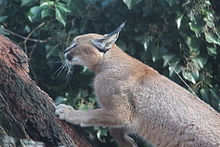
The caracal is typically nocturnal (active at night), though some activity may be observed during the day as well. However, the cat is so secretive and difficult to observe that its activity at daytime might easily go unnoticed.[19] A study in South Africa showed that caracals are most active when air temperature drops below 20 °C (68 °F); activity typically ceases at higher temperatures.[22] A solitary cat, the caracal mainly occurs alone or in pairs; the only groups seen are of mothers with their offspring.[16] Females in oestrus temporarily pair with males. A territorial animal, the caracal marks rocks and vegetation in its territory with urine and probably with dung, which is not covered with soil. Claw scratching is prominent, and dung middens are typically not formed.[18] In Israel, males are found to have territories averaging 220 km2 (85 sq mi), while that of females averaged 57 km2 (22 sq mi). The male territories vary from 270–1,116 km2 (104–431 sq mi) in Saudi Arabia. In Mountain Zebra National Park (South Africa), the female territories vary between 4.0 and 6.5 km2 (1.5 and 2.5 sq mi). These territories overlap extensively.[17] The conspicuous ear tufts and the facial markings often serve as a method of visual communication; caracals have been observed interacting with each other by moving the head from side to side so that the tufts flicker rapidly. Like other cats, the caracal meows, growls, hisses, spits, and purrs.[16]
Diet and hunting

A carnivore, the caracal typically preys upon small mammals, birds, and rodents. Studies in South Africa have reported that it preys on the Cape grysbok, the common duiker, sheep, goats, bush vlei rats, rock hyraxes, hares, and birds.[23][24][25] A study in western India showed that rodents comprise a significant portion of the diet.[26] They will feed from a variety of sources, but tend to focus on the most abundant one.[27] Grasses and grapes are taken occasionally to clear their immune system and stomach of any parasites.[28] Larger antelopes such as young kudu, bushbuck, impala, mountain reedbuck, and springbok may also be targeted. Mammals generally comprise at least 80% of the diet.[18] Lizards, snakes, and insects are infrequently eaten.[1] They are notorious for attacking livestock, but rarely attack humans.[21]
Its speed and agility make it an efficient hunter, able to take down prey two to three times its size.[1] The powerful hind legs allow it to leap more than 3 m (10 ft) in the air to catch birds on the wing.[17][29][30] It can even twist and change its direction mid-air.[17] It is an adroit climber.[17] It stalks its prey until it is within 5 m (16 ft), following which it can launch into a sprint. While large prey such as antelopes are killed by a throat bite, smaller prey are suffocated by a bite on the back of the neck.[17] Kills are consumed immediately, and less commonly dragged to cover. It returns to large kills if undisturbed.[18] It has been observed to begin feeding on antelope kills at the hind parts.[19] It may scavenge at times, though this has not been frequently observed.[23] It often has to compete with foxes, wolves, leopards, and hyaena for prey.[21]
Reproduction
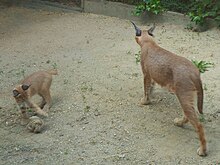
Both sexes become sexually mature by the time they are a year old; production of gametes begins even earlier at seven to ten months. However, successful mating takes place only at 12 to 15 months. Breeding takes place throughout the year. Oestrus, one to three days long, recurs every two weeks unless the female is pregnant. Females in oestrus show a spike in urine-marking, and form temporary pairs with males. Mating has not been extensively studied; limited number of observations suggest that copulation, that lasts nearly four minutes on an average, begins with the male smelling the areas urine-marked by the female, which rolls on the ground. Following this, he approaches and mounts the female. The pair separates after copulation.[17][18]
Gestation lasts about two to three months, following which a litter consisting of one to six kittens is born. Births generally peak from October to February. Births take place in dense vegetation or deserted burrows of aardvarks and porcupines. Kittens are born with their eyes and ears shut and the claws not retractable (unable to be drawn inside); the coat resembles that of adults, but the abdomen is spotted. Eyes open by ten days, but it takes longer for the vision to become normal. The ears become erect and the claws become retractable by the third or the fourth week. Around the same time, the kittens start roaming their birthplace, and start playing among themselves by the fifth or the sixth week. They begin taking solid food around the same time; they have to wait for nearly three months before they make their first kill. As the kittens start moving about by themselves, the mother starts shifting them everyday. All the milk teeth appear in 50 days, and permanent dentition is completed in 10 months. Juveniles begin dispersing at nine to ten months, though a few females stay back with their mothers. The average lifespan of the caracal in captivity is nearly 16 years.[17][21][31]
Distribution and habitat
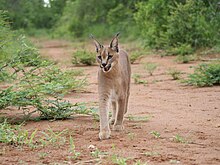
In Africa, the caracal is widely distributed south of the Sahara, but considered rare in North Africa. In Asia, it occurs from the Arabian Peninsula, Middle East, Turkmenistan, Uzbekistan to western India.[1] It inhabits forests, savannas, marshy lowlands, semideserts, and scrub forests, but prefers dry areas with low rainfall and availability of cover. In montane habitats such as the Ethiopian Highlands, it occurs up to an altitude of 3,000 m (9,800 ft).[18]
Threats and conservation
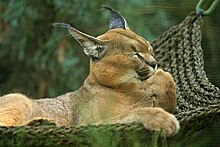
The caracal is categorised as least concern by the International Union for Conservation of Nature and Natural Resources; African populations are listed under CITES Appendix II, while Asian populations come under CITES Appendix I. In central, west, north, and northeast Africa and Asia, the major threat to the survival of the caracal is habitat loss due to agricultural expansion and desertification. Caracal are often killed in retaliation for preying on small livestock. A 1989 survey revealed that the caracal was responsible for the elimination of nearly 5.3 livestock per 100 km2 (39 sq mi) per year in the erstwhile Cape Province, South Africa. During 1931–52, the number of caracals killed averaged 2,219 per year in the Karoo. Some tribes kill it for its meat. As of 1996, hunting of caracals is prohibited in Afghanistan, Algeria, Egypt, India, Iran, Israel, Jordan, Kazakhstan, Lebanon, Morocco, Pakistan, Syria, Tajikistan, Tunisia, Turkey, Turkmenistan, and Uzbekistan. However, Namibia and South Africa recognise it as a "problem animal" (vermin) and allow its hunting to protect livestock. Caracals occur in a number of protected areas across their range.[1]
In culture
Chinese emperors used caracals as gifts. In the 13th and the 14th centuries, Yuan dynasty rulers bought numerous caracals, cheetahs, and tigers from Muslim merchants in the western parts of the empire in return for gold, silver, cash, and silk. According to the Ming Shilu, the subsequent Ming dynasty continued this practice. Until as recently as the 20th century, the caracal was used in hunts by Indian rulers to hunt small game, while the cheetah was used for larger game.[32] In those times, caracals were exposed to a flock of pigeons and people would bet on which caracal would kill the largest number of pigeons. This probably gave rise to the expression "to put the cat among the pigeons".[30]
The caracal appears to have been religiously significant in the Egyptian culture, as it occurs in paintings and as bronze figurines; sculptures were believed to guard the tombs of pharaohs. Embalmed caracals have also been discovered. Its pelt was used for making fur coats.[21]
References
Citations
- ^ a b c d e Template:IUCN
- ^ a b Wozencraft, W. C. (2005). "Order Carnivora". In Wilson, D. E.; Reeder, D. M. (eds.). Mammal Species of the World: A Taxonomic and Geographic Reference (3rd ed.). Johns Hopkins University Press. p. 533. ISBN 978-0-8018-8221-0. OCLC 62265494.
- ^ Faure, E.; Kitchener, A. C. (2009). "An archaeological and historical review of the relationships between felids and people". Anthrozoös. 22 (3): 221–238.
- ^ Malek, J. (1997). The cat in ancient Egypt. University of Pennsylvania Press.
- ^ Scheber, J.C.D. (1777). "Der Karakal". Die Säugethiere in Abbildungen nach der Natur mit Beschreibungen. Erlangen: Wolfgang Walther. pp. 413–414.
{{cite book}}: External link in|chapterurl=|chapterurl=ignored (|chapter-url=suggested) (help) - ^ "A revised taxonomy of the Felidae: The final report of the Cat Classification Task Force of the IUCN Cat Specialist Group" (PDF). Cat News. Special Issue 11. 2017.
{{cite journal}}: Unknown parameter|authors=ignored (help) - ^ a b Johnson, W. E. (2006). "The late Miocene radiation of modern Felidae: A genetic assessment". Science. 311 (5757): 73–7. Bibcode:2006Sci...311...73J. doi:10.1126/science.1122277. PMID 16400146.
- ^ Johnson, WE; O'Brien, SJ (1997). "Phylogenetic reconstruction of the Felidae using 16S rRNA and NADH-5 mitochondrial genes". Journal of Molecular Evolution. 44 Suppl. 1: S98–116. Bibcode:1997JMolE..44S..98J. doi:10.1007/PL00000060. PMID 9071018.
- ^ a b Werdelin, L.; Yamaguchi, N.; Johnson, W.E.; O'Brien, S.J. (2010). "Phylogeny and evolution of cats (Felidae)" (PDF). Biology and Conservation of Wild Felids: 59–82.
- ^ Gittleman, J., ed. (1989). Carnivore Behavior, Ecology, and Evolution. New York: Cornell University Press.
- ^ "Caracal". Merriam-Webster.com Dictionary. Merriam-Webster.
- ^ EB (1911), p. 297.
- ^ a b EB (1878), p. 81.
- ^ Encyclopædia Britannica, 9th ed., Vol. XXV, 1889, p. 81.
- ^ Nowak, R.M. (1999). Walker's Mammals of the World (6th ed.). Baltimore, Maryland, US: Johns Hopkins University Press. pp. 810–1. ISBN 978-0-8018-5789-8.
- ^ a b c d Estes, R.D. (2004). The Behavior Guide to African Mammals: Including Hoofed Mammals, Carnivores, Primates (4th ed.). Berkeley, California, US: University of California Press. pp. 363–5. ISBN 978-0520-080-850.
- ^ a b c d e f g h i j k l Sunquist, F.; Sunquist, M. (2002). "Caracal Caracal caracal". Wild Cats of the World. Chicago: University of Chicago Press. pp. 38–43. ISBN 978-0-226-77999-7.
- ^ a b c d e f g h i Kingdon, J. (1997). The Kingdon Field Guide to African Mammals (2nd ed.). London, UK: Bloomsbury Publishing Plc. pp. 174–179. ISBN 978-1472-912-367.
- ^ a b c d Skinner, J.D.; Chimimba, C.T. (2006). The Mammals of the Southern African Sub-region (3rd (revised) ed.). Cambridge, UK: Cambridge University Press. pp. 397–400. ISBN 978-1107-394-056.
- ^ Liebenberg, Louis (1990). A Field Guide to the Animal Tracks of Southern Africa. Cape Town, South Africa: D. Philip. pp. 257–8. ISBN 978-0864-861-320.
- ^ a b c d e Heptner, V. G.; Sludskij, A. A. (1992) [1972]. "Caracal". Mlekopitajuščie Sovetskogo Soiuza. Moskva: Vysšaia Škola [Mammals of the Soviet Union. Volume II, Part 2. Carnivora (Hyaenas and Cats)]. Washington DC: Smithsonian Institution and the National Science Foundation. pp. 498–524. ISBN 90-04-08876-8.
{{cite book}}: External link in|chapterurl=|chapterurl=ignored (|chapter-url=suggested) (help) - ^ Avenant, N.L.; Nel, J.A.J. (1998). "Home-range use, activity, and density of caracal in relation to prey density". African Journal of Ecology. 36 (4): 347–59. doi:10.1046/j.1365-2028.1998.00152.x.
- ^ a b Stuart, C.T.; Hickman, G.C. (1991). "Prey of caracal (Felis caracal) in two areas of Cape Province, South Africa". Journal of African Zoology. 105 (5): 373–81.
- ^ Palmer, R.; Fairall, N. (1988). "Caracal and African wild cat diet in the Karoo National Park and the implications thereof for hyrax" (PDF). S. Afr. J. Wildl. Res./S.-Afr. Tydskr. Natuurnav. 18 (1): 30–4.
- ^ Grobler, J.H. (1981). "Feeding behaviour of the caracal Felis caracal (Schreber 1776) in the Mountain Zebra National Park". South African Journal of Zoology. 16 (4): 259–62. doi:10.1080/02541858.1981.11447764.
- ^ Mukherjee, S.; Goyal, S.P.; Johnsingh, A.J.T.; Pitman, M.R.P.L. (2004). "The importance of rodents in the diet of jungle cat (Felis chaus), caracal (Caracal caracal) and golden jackal (Canis aureus) in Sariska Tiger Reserve, Rajasthan, India" (PDF). Journal of Zoology. 262 (4): 405–11. doi:10.1017/S0952836903004783.
- ^ Avenant, N.L.; Nel, J.A.J. (2002). "Among habitat variation in prey availability and use by caracal Felis caracal". Mammalian Biology – Zeitschrift für Säugetierkunde. 67 (1): 18–33. doi:10.1078/1616-5047-00002.
- ^ Bothma, J.D.P. (1965). "Random observations on the food habits of certain Carnivora (Mammalia) in southern Africa". Fauna and Flora. 16: 16–22.
- ^ Kohn, T.A.; Burroughs, R.; Hartman, M.J.; Noakes, T.D. (2011). "Fiber type and metabolic characteristics of lion (Panthera leo), caracal (Caracal caracal) and human skeletal muscle". Comparative Biochemistry and Physiology A. 159 (2): 125–33. doi:10.1016/j.cbpa.2011.02.006. PMID 21320626.
- ^ a b Sunquist, F.; Sunquist, M. (2014). The Wild Cat Book: Everything You Ever Wanted to Know about Cats. Chicago, US: The University of Chicago Press. pp. 87–91. ISBN 978-0226-780-269.
- ^ Bernard, R.T.F.; Stuart, C.T. (1986). "Reproduction of the caracal Felis caracal from the Cape Province of South Africa" (PDF). South African Journal of Zoology. 22 (3): 177–82. doi:10.1080/02541858.1987.11448043.
- ^ Mair, V.H. (2006). Contact and exchange in the ancient world. Hawai'i, Honolulu: University of Hawai'i Press. pp. 116–123. ISBN 978-0-8248-2884-4.
Further reading
- , Encyclopædia Britannica, 9th ed., Vol. V, New York: Charles Scribner's Sons, 1878, pp. 80–1.
- , Encyclopædia Britannica, 11th ed., Vol. V, Cambridge: Cambridge University Press, 1911, pp. 297–8.
External links
- IUCN Cat Specialist Group : Caracal
- Mammal's Planet: Research – Identification
- Cats For Africa : Caracal Distribution
- IUCN Red List least concern species
- Caracal (genus)
- Mammals of Southwest Asia
- Mammals of India
- Mammals of the Middle East
- Mammals of Pakistan
- Fauna of Egypt
- Fauna of Saudi Arabia
- Fauna of Yemen
- Fauna of Oman
- Fauna of Jordan
- Monotypic mammal genera
- Felids of Africa
- Desert fauna
- Mammals described in 1777
- Mammals of Turkey
- Mammals of Africa
- Mammals of Asia

